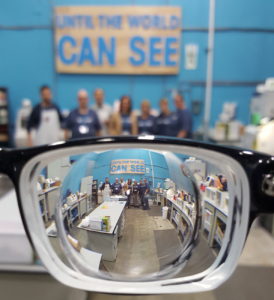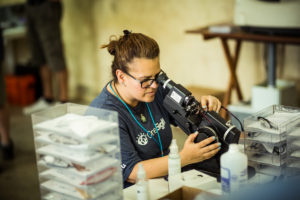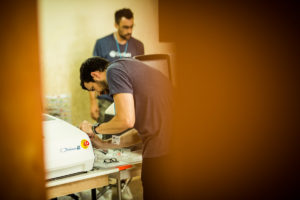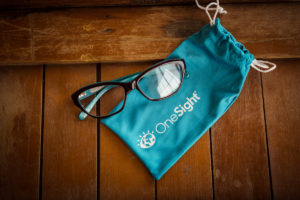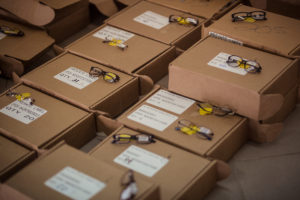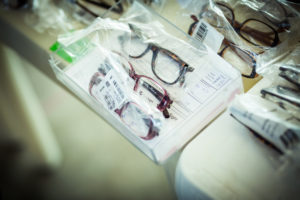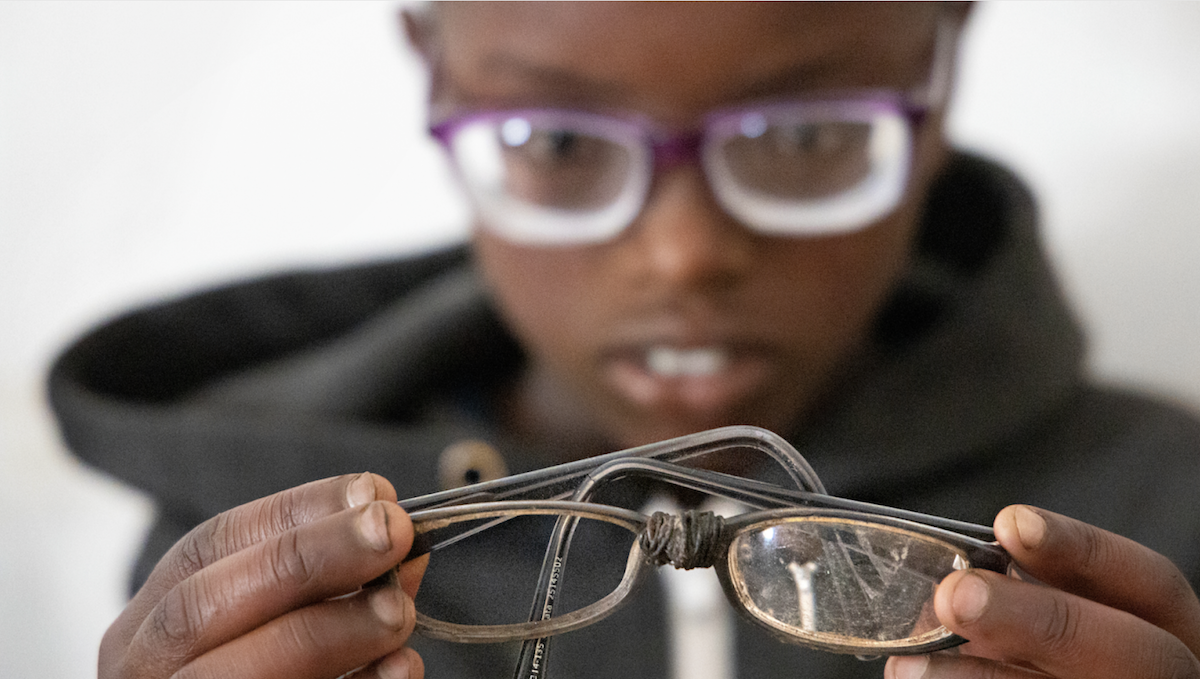
It may seem like the magic happens the moment a patient receives their pair of glasses – but the real magic actually begins long before the glasses reach their new owner. A pair of spectacles’ life begins within a manufacturing lab – a special workshop staffed by heros of sight. These individuals take the doctor’s script and transform it into a life-changing tool: a pair of prescription glasses. Something we like to call “handcrafted change.”
OUR LABS
Nestled in the suburbs surrounding OneSight’s HQ in West Chester, OH lies our Regional Operations Center (ROC) manufacturing lab. This lab is responsible for fulfilling OneSight orders from all over the world, crafting nearly all high RX prescriptions we receive. They also create all orders placed from the vision van and sustainable vision centers in North America, support manufacturing for Africa centers while they’re in their pilot phase, and get called in to help third party organizations craft complex prescriptions. Our ROC lab & its staff have earned themselves quite a reputation for being an expert in the field. In fact, they have yet to receive an order they couldn’t deliver – taking on challenges as difficult as a -30 RX!
Not all of our glasses make it into our ROC lab – some are crafted on clinic sites, in our global sustainable centers or on the road. Others are sent out to regional manufacturers in order to serve our patients more quickly. But all of them are handcrafted with quality and care – and of course a lot of love, too.
HOW IT WORKS:
All of OneSight’s manufacturing work falls into two types of processes: Finishing & Surfacing. The main difference between these two processes stems from the initial type of lens used. In a finishing process, the lens you start with already has a prescription in it. Surfacing, on the other hand, offers a start-from-scratch approach, beginning with a blank lens and requiring the etching of 3 curves on the blank to create a prescription. We use both of these processes in our work, but often choose to use finishing for nimble approaches (think charitable clinics or accessing remote areas) and surfacing for orders that are more complex or unique.
HOW GLASSES ARE MADE:
SURFACING
STEP #1: DATA ENTRY
This is where we take all of the data given to us by the doctors and load it into our manufacturing system.
STEP #2: VERIFICATION
When we pause to verify the data and angles we entered before moving forward with the lens.
STEP #3: MARKING & TAPING
This is where the lens get first marked, which will set the angle of script. Also where a thin protective layer of tape gets applied.
STEP #4: GENERATING
Remember that data we entered in Step #1? Well, now it’s time to put it to use. We use what’s called “XYZ generating” to create a script. Our blank lens now has a prescription in it, but it’s not quite ready to go yet…
STEP #5: BLOCKING
We use something called a “block” as a holder for the lense and use a bonding agent to attach the two. After waiting awhile for the two to attach, we’ll move on to sanding. Our lens still has a rough finish to it, so we must sand it down to create a smooth, clear lens. When we’re finished with this step, our lens will be almost completely clear, but still have a touch of milkiness to it.
STEP #6: POLISHING
Now that we’ve sanded the lens, we’ll clean it off some more. The final product? A crystal clear lense that’s ready to have the block detached and be inspected for any flaws.
STEP #7: COATING
This step really depends on what kind of material our lens is made out of. If it’s a polycarbonate material, we’ll send it into coating.If it’s a plastic lens, we’ll continue on with what’s called prescription verification (our next step).
FINISHING BEGINS
STEP #8: PRESCRIPTION VERIFICATION
This is the moment in which a surfacing process becomes a finishing one – or the moment in which a finishing process begins. Prescription verification is a key part of the manufacturing process, as it ensures quality and optical clarity.
⭐️STEP 9: EDGING⭐️
This is the moment we’ve all been waiting for – the moment when a lens becomes the change. This is the step in which you carefully craft the shape of the lens to match the set of frames a patient has specially selected. When you take the prescription lens you’ve worked so hard on and place it into frames. This is the moment in which a pair of lenses becomes a pair of glasses, forming a powerful tool that’s full of potential – both for the patient and for every person they come into contact with in the years to come.
STEP #10: CLEAN & INSPECT
Perhaps our most important step is the last one, in which we clean and examine the pair of glasses to ensure that everything is perfect before placing them in a case and sending them off to their new owner.
THE MAGIC BEHIND THE MANUFACTURING
Handcrafted change at its core begins with purpose-driven teams. Our lab teams – whether staff or volunteers – are passionate about what they do and who they serve. While they know their skills and successes often tend to lie in the behind-the-scenes, they’re proud of what they’ve accomplished together and know that each pair of glasses they craft creates a ripple effect that goes beyond the specs themselves.
To paint you a picture of what we’re talking about, OneSight Manager of Global Fulfillment, Dawid Drozdz, shares a personal story that changed his life:
“I was a technician in a Luxottica lab based in Chicago, IL. Our lab would always get boxes of work to complete and we weren’t sure where it came from. One day my lab manager told me to go check out a OneSight clinic in a nearby neighborhood to see just where those boxes were coming from. It was at that clinic that I met a little boy named DeShawn who put everything in perspective for me. He was a high energy boy who was constantly running around and frustrating his teachers. You would see him constantly grabbing people’s faces and pulling them closely or talking way too close to someone’s face. As he went through the clinic process, we noticed that he had a crazy high RX – he couldn’t see anything past his fingertips. At 12 years old, he had never had a pair of glasses or even knew he needed some. Suddenly, it all made sense why DeShawn was always running around and grabbing people closely. He couldn’t see them. That day I got to make him a pair of glasses, and simultaneously I fell in love with OneSight. It’s been 14 years since then, and I can still remember DeShawn’s face and exactly how I felt. I got to change someone’s life & start a ripple effect that has the potential to influence every person that little boy comes into contact with.”
That’s the magic behind a pair of glasses. The workmanship, story and the potential that they carry. Interested in learning more about the vision care gap and why we’re working to close it? Explore our why.
Follow us on Instagram, Facebook, Twitter and LinkedIn for more stories of sight.
